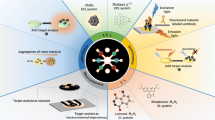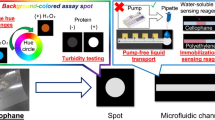Abstract
Microfluidic-based biosensors have been developed for their precise automatic reaction control. However, these biosensors require external devices that are difficult to transport and use. To overcome this disadvantage, our group made an easy-to-use, cheap, and light pumpless three-dimensional photo paper–based microfluidic analytical device (3D-μPAD; weight: 1.5 g). Unlike conventional paper-based microfluidic analytical devices, the 3D-μPAD can be used to control fluid flow in a 3D manner, thus allowing sophisticated multi-step reaction control. This device can control fluid flow speed and direction accurately using only the capillary-driven flow without an external device like a pump. The flow speed is controlled by the width of the microfluidic channel and its surface property. In addition, fluid speed control and 3D-bridge structure enable the control of fluid flow direction. Using these methods, multi-step enzyme-linked immunosorbent assay (ELISA) can be done automatically in sequence by injecting solutions (sample, washing, and enzyme’s substrate) at the same time in the 3D-μPAD. All the steps can be performed in 14 min, and data can be analyzed immediately. To test this device, thioredoxin-1 (Trx-1), a biomarker of breast cancer, is used as the target. In the 3D-μPAD, it can detect 0–200 ng/mL of Trx-1, and the prepared 3D-μPAD Trx-1 sensor displays excellent selectivity. Moreover, by analyzing the concentration of Trx-1 in real patients and healthy individuals’ blood serum samples using the 3D-μPAD, and comparing results to ELISA, it can be confirmed that the 3D-μPAD is a good tool for cancer diagnosis.
Graphical abstract







Similar content being viewed by others
References
Mitchell KR, Esene JE, Woolley AT. Advances in multiplex electrical and optical detection of biomarkers using microfluidic devices. Anal Bioanal Chem. 2021. https://doi.org/10.1007/s00216-021-03553-8.
Hernández-Rodríguez JF, Rojas D, Escarpa A. Rapid and cost-effective benchtop microfabrication of disposable carbon-based electrochemical microfluidic devices. Sens Actuators B Chem. 2020;324: 128679. https://doi.org/10.1016/j.snb.2020.128679.
Zhuang JJ, Yin JX, Lv SW, Wang B, Mu Y. Advanced “lab-on-a-chip” to detect viruses - current challenges and future perspectives. Biosens Bioelectron. 2020;163. https://doi.org/10.1016/j.bios.2020.112291
Dekker S, Buesink W, Blom M, Alessio M, Verplanck N, Hihoud M, et al. Standardized and modular microfluidic platform for fast lab on chip system development. Sens Actuators B Chem. 2018;272:468–78. https://doi.org/10.1016/j.snb.2018.04.005.
Ye WQ, Wei YX, Zhang YZ, Yang CG. Xu ZR Multiplexed detection of micro-RNAs based on microfluidic multi-color fluorescence droplets. Anal Bioanal Chem. 2020;412(3):647–55. https://doi.org/10.1007/s00216-019-02266-3.
Godinez-Brizuela OE, Niasar VJ. Simultaneous pressure and electro-osmosis driven flow in charged porous media: pore-scale effects on mixing and dispersion. J Colloid Interface Sci. 2020;561:162–72. https://doi.org/10.1016/j.jcis.2019.11.084.
Li J, Kim CJ. Current commercialization status of electrowetting-on-dielectric (EWOD) digital microfluidics. Lab Chip. 2020;20(10):1705–12. https://doi.org/10.1039/D0LC00144A.
Wang ML, Song ZH, Jiang YW, Zhang XL, Wang L, Zhao HY, Cui YT, Gu FR, Wang YH, Zheng GX. A three-dimensional pinwheel-shaped paper-based microfluidic analytical device for fluorescence detection of multiple heavy metals in coastal waters by rational device design. Anal Bioanal Chem. 2021;413(12):3299–313. https://doi.org/10.1007/s00216-021-03269-9.
Jin L, Hao Z, Zheng Q, Chen H, Zhu L, Wang C, et al. A facile microfluidic paper-based analytical device for acetylcholinesterase inhibition assay utilizing organic solvent extraction in rapid detection of pesticide residues in food. Anal Chim Acta. 2020;1100:215–24. https://doi.org/10.1016/j.aca.2019.11.067.
Calabria D, Calabretta MM, Zangheri M, Marchegiani E, Trozzi I, Guardigli M, et al. Recent advancements in enzyme-based lateral flow immunoassays. Sensors. 2021;21(10):3358. https://doi.org/10.3390/s21103358.
Sharifi H, Tashkhourian J, Hemmateenejad B. A 3D origami paper-based analytical device combined with PVC membrane for colorimetric assay of heavy metal ions: application to determination of Cu(II) in water samples. Anal Chim Acta. 2020;1126:114–23. https://doi.org/10.1016/j.aca.2020.06.006.
Noiphung J, Laiwattanapaisal W. Multifunctional paper-based analytical device for in situ cultivation and screening of Escherichia coli infections. Sci Rep. 2019;9(1):1555. https://doi.org/10.1038/s41598-018-38159-1.
Preechakasedkit P, Siangproh W, Khongchareonporn N, Ngamrojanavanich N, Chailapakul O. Development of an automated wax-printed paper-based lateral flow device for alpha-fetoprotein enzyme-linked immunosorbent assay. Biosens Bioelectron. 2018;102:27–32. https://doi.org/10.1016/j.bios.2017.10.051.
Shangguan J-W, Liu Y, Wang S, Hou Y-X, Xu B-Y, Xu J-J, et al. Paper capillary enables effective sampling for microfluidic paper analytical devices. Acs Sens. 2018;3(7):1416–23. https://doi.org/10.1021/acssensors.8b00335.
Shou D, Fan J. Design of nanofibrous and microfibrous channels for fast capillary flow. Langmuir. 2018;34(4):1235–41. https://doi.org/10.1021/acs.langmuir.7b01797.
Glavan AC, Martinez RV, Maxwell EJ, Subramaniam AB, Nunes RMD, Soh S, et al. Rapid fabrication of pressure-driven open-channel microfluidic devices in omniphobic R-F paper. Lab Chip. 2013;13(15):2922–30. https://doi.org/10.1039/C3LC50371B.
Yukird J, Soum V, Kwon OS, Shin K, Chailapakul O, Rodthongkum N. 3D paper-based microfluidic device: a novel dual-detection platform of bisphenol A. Analyst. 2020;145(4):1491–8. https://doi.org/10.1039/C9AN01738K.
Songok J, Toivakka M. Enhancing capillary-driven flow for paper-based microfluidic channels. ACS Appl Mater Interfaces. 2016;8(44):30523–30. https://doi.org/10.1021/acsami.6b08117.
Hemmig E, Temiz Y, Gökçe O, Lovchik RD, Delamarche E. Transposing lateral flow immunoassays to capillary-driven microfluidics using self-coalescence modules and capillary-assembled receptor carriers. Anal Chem. 2020;92(1):940–6. https://doi.org/10.1021/acs.analchem.9b03792.
Hassan S-u, Zhang X. Design and fabrication of capillary-driven flow device for point-of-care diagnostics. Biosensors. 2020;10(4):39. https://doi.org/10.3390/bios10040039
Soum V, Park S, Brilian AI, Kwon O-S, Shin K. Programmable paper-based microfluidic devices for biomarker detections. Micromachines-Basel. 2019;10(8):516. https://doi.org/10.3390/mi10080516.
Soum V, Park S, Brilian AI, Choi JY, Lee Y, Kim W, et al. Quantitatively controllable fluid flows with ballpoint-pen-printed patterns for programmable photo-paper-based microfluidic devices. Lab Chip. 2020;20(9):1601–11. https://doi.org/10.1039/D0LC00115E.
Ma L, Abugalyon Y, Li XJ. Multicolorimetric ELISA biosensors on a paper/polymer hybrid analytical device for visual point-of-care detection of infection diseases. Anal Bioanal Chem. 2021;413(18):4655–63. https://doi.org/10.1007/s00216-021-03359-8.
Zhan S, Zheng L, Zhou Y, Wu K, Duan H, Huang X, et al. A gold growth-based plasmonic ELISA for the sensitive detection of fumonisin B1 in maize. Toxins. 2019;11(6):323. https://doi.org/10.3390/toxins11060323.
Shang C, Wang Z, Liu H. A terminal antibody method based on multiple factors that influence ELISA results for measurement of antibody affinity in clinical specimens. J Virol Methods. 2017;240:42–8. https://doi.org/10.1016/j.jviromet.2016.11.009.
Park B-J, Cha M-K, Kim I-H. Thioredoxin 1 as a serum marker for breast cancer and its use in combination with CEA or CA15-3 for improving the sensitivity of breast cancer diagnoses. BMC Res Notes. 2014;7(1):7. https://doi.org/10.1186/1756-0500-7-7.
Liu YP, Zhao Y, Wei ZH, Tao L, Sheng XB, Wang SL, et al. Targeting thioredoxin system with an organosulfur compound, diallyl trisulfide (DATS), attenuates progression and metastasis of triple-negative breast cancer (TNBC). Cell Physiol Biochem. 2018;50(5):1945–63. https://doi.org/10.1159/000494874.
Lee MJ, Yeom J, Choi JH, Shin JH, Kim TH, Jeon JW, et al. Pump-free glass-based capillary microfluidic immuno-assay chip for electrochemical detection of prostate-specific antigen. J Nanosci Nanotechnol. 2020;20(8):4629–33. https://doi.org/10.1166/jnn.2020.17831.
Park J. An optimized colorimetric readout method for lateral flow immunoassays. Sensors. 2018;18(12):4084. https://doi.org/10.3390/s18124084.
Dehus O, Zimmer J, Doring S, Fuhrer F, Hanschmann KM, Holzhauser T, Neske F, Strecker D, Trosemeier JH, Vieths S, Kaul S. Development and in-house validation of an allergen-specific ELISA for quantification of Bet v 4 in diagnostic and therapeutic birch allergen products. Anal Bioanal Chem. 2015;407(6):1673–83. https://doi.org/10.1007/s00216-014-8418-z.
Chaikhan P, Udnan Y, Sananmuang R, Ampiah-Bonney RJ, Chuachuad CW. A low-cost microfluidic paper-based analytical device (μPAD) with column chromatography preconcentration for the determination of paraquat in vegetable samples. Microchem J. 2020;159: 105355. https://doi.org/10.1016/j.microc.2020.105355.
Funding
This work was supported by Korea Environment Industry & Technology Institute (KEITI) through the program for the management of aquatic ecosystem health, funded by Korea Ministry of Environment (MOE) (2020003030001), and Korea Institute of Energy Technology Evaluation and Planning (KETEP) grant funded by the Korea government (MOTIE) (20214000000500, training program of CCUS for the green growth).
Author information
Authors and Affiliations
Corresponding authors
Ethics declarations
Ethics approval
The blood samples were obtained from “For YOU Moon’s” Maternity hospital. Written informed consent was obtained from each participant.
Conflict of interest
Sang-nam Lee was employed by the company Uniance Gene Inc. The remaining authors declare no competing interests.
Additional information
Publisher's note
Springer Nature remains neutral with regard to jurisdictional claims in published maps and institutional affiliations.
Published in the topical collection Point-of-Care Testing with guest editors Oliver Hayden, Peter B. Luppa, and Junhong Min.
Supplementary Information
Below is the link to the electronic supplementary material.
Rights and permissions
About this article
Cite this article
Lee, MJ., Soum, V., Lee, SN. et al. Pumpless three-dimensional photo paper–based microfluidic analytical device for automatic detection of thioredoxin-1 using enzyme-linked immunosorbent assay. Anal Bioanal Chem 414, 3219–3230 (2022). https://doi.org/10.1007/s00216-021-03747-0
Received:
Revised:
Accepted:
Published:
Issue Date:
DOI: https://doi.org/10.1007/s00216-021-03747-0




